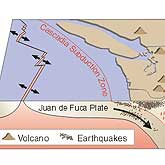Silent Earthquakes
 Try this demonstration of earthquake movement. Shape modeling clay into two blocks or get two firm sponge blocks. Press the sides of the blocks together while trying to slide them slowly past each other. You may notice that they stick at first, then suddenly slide. This is much like what happens when earth's plates (large sections of earth's solid upper layers) are forced past each other causing earthquakes, whether one plate slides and bumps past another or one moves over the other. However, slow moving 'silent' quakes have been discovered occurring deep beneath Washington state and British Columbia, Canada. Here the Juan de Fuca Plate is being forced below the North American plate, but the movement has been so slow, it was not originally detected by seismograph analysis. It was data from the satellites in the GPS (Global Positioning System) that detected the very slight movements of stations on the ground.
Try this demonstration of earthquake movement. Shape modeling clay into two blocks or get two firm sponge blocks. Press the sides of the blocks together while trying to slide them slowly past each other. You may notice that they stick at first, then suddenly slide. This is much like what happens when earth's plates (large sections of earth's solid upper layers) are forced past each other causing earthquakes, whether one plate slides and bumps past another or one moves over the other. However, slow moving 'silent' quakes have been discovered occurring deep beneath Washington state and British Columbia, Canada. Here the Juan de Fuca Plate is being forced below the North American plate, but the movement has been so slow, it was not originally detected by seismograph analysis. It was data from the satellites in the GPS (Global Positioning System) that detected the very slight movements of stations on the ground.
Far offshore from Oregon, Washington, and British Columbia, the Pacific Plate and the Juan de Fuca Plate are being forced apart by convection currents in earth's mantle. (See the ScienceIQ Geology fact on Plate Tectonics from 11/02.) This moves the Juan de Fuca plate eastward where it collides with and is subducted under the North American plate. But not all parts of the massive plates move equally. Deeper in the earth, the subducted portion of the plate becomes pliable as it is heated, and it moves more easily, while colder, shallower sections of the plate get stuck, and pressure continually builds. This would be like forcing your fingers into a narrow opening. Some fingers might slide in easily, but you would feel pressure build up on the stuck fingers. The continued sliding of the moving fingers - or plate sections - does not reduce total stress because it causes stress to increase in the locked zones.
Since plate movement in the pliable regions is so slow, the massive earthquake energy is also being released very slowly, and no quaking is noticed. Scientists think the energy being released is equivalent to what would normally occur during a 6 to 7 magnitude quake, but is being released over weeks, not seconds, so the smaller quakes are much less powerful. The end result, however, may not be less destructive earthquakes. Since pressure builds up in the locked zones of plate boundaries, the energy may later be released in a quake of much greater magnitude. If the movement occurred at the western edge of the Juan de Fuca plate, devastating tsunamis could be generated and the entire region would be shaken. Such a release is believed to occur somewhere along the Juan de Fuca's boundaries about every 500 years in massive 8 or 9 magnitude earthquakes. The sensitive GPS detection of even very slight surface movements may provide a means of predicting such quakes, allowing advance warning.
About the Author
Claire-Jean Korzenewski, BS
 Claire-Jean Korzenewski has a B.S. in geology and experience in petroleum exploration. She is an educator with public school teaching experience in junior high and high school sciences. Claire-Jean is now a freelance writer who makes communications more effective - to inform, to educate, and to enhance profits for businesses and individuals.
Claire-Jean Korzenewski has a B.S. in geology and experience in petroleum exploration. She is an educator with public school teaching experience in junior high and high school sciences. Claire-Jean is now a freelance writer who makes communications more effective - to inform, to educate, and to enhance profits for businesses and individuals.


